First off, a big congratulations to Harry Legrand for correctly identifying the nest as belonging to a tinamou...impressive!

He was off with his species guess of Cinereous...this was actually a Bartlett's (correct me if I'm wrong!)
Now before I dive headfirst into the Amazon I should mention that I will be paraphrasing myself from my other blog's post from back in April: Elementary my dear Hoatzin. If this current post leaves you wanting more (like pictures of monkeys), then follow that link.
Alright let's give this place some context:
View Larger Map
Yeah, this place is a bit out of the way. Travel from the nearest airport (Coca) takes 6 hours and 3 legs via boat, truck and motorized canoe. So you'll have to budget a day of travel each way.
They neither solicit nor discourage "tourists" or birders from visiting; the station is primarily for researchers: tropical ecologists, primatologists, ornithologists, etc. to conduct field work. So it has a much different (and refreshing) vibe to it, than the standard Amazonian ecotourism lodge. They do have fantastic and knowledgable resident guides who know all of the place's 550+ species and ours, Jose, showed spent a couple days enthusiastically leading us around a few of the trails.
I ended up at Tiputini because I had the serendipity to meet one of the station's directors, Prof. Kelly Swing, while he was visiting La Hesperia with a group of students.
I managed to convince my buddy, Peter Capobianco, to fly down from the states to get in on the trip as well.
Anyway, on to the birds:
What stood out most about the bird life at Tiputini, aside from the staggering total species diversity, is that so many of the birds encountered were considered either "rare, scarce or local" according to the field guide (Ridgley and Greenfield). Most birds were encountered only a single time. For a serious birdwatcher this does demand constant vigilance as a once-in-a-lifetime type species could show itself at any moment and then disappear just as quickly. For us this happened when were were with Jose when he spotted an (to us anyway) invisible Rufous-vented Ground Cuckoo. He said it was the second one he had seen at Tiputini in four years. Don't worry I made up for it later at Jatun Sacha Bilsa (account coming soon to a blog near you!).
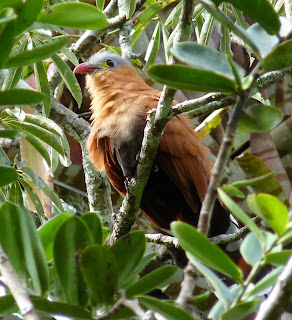
Not a mega-bird, but one example of something "rare" that cooperated for a photo was this Black-bellied Cuckoo that joined us in the 35-meter canopy tower. We must have spent 40 hours in that tower over the course of our six full days at the station. It was an awesome spot to see passing groups of macaws (we saw lots of Scarlet as well as Blue-and-Yellow and Chestnut-fronted), canopy flocks (loaded with Paradise, Opal-rumped and Opal-crowned Tanagers) and various toucans including:
Many-banded Aracari.

And here a Common Piping-Guan:
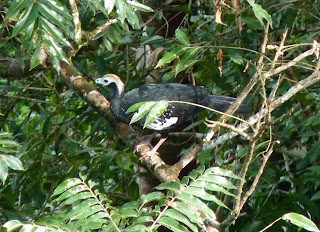
...and a Double-toothed Kite:
...also joined us in the canopy tower.
Along the river we found a foolishly tame juvenile Great Black-Hawk:
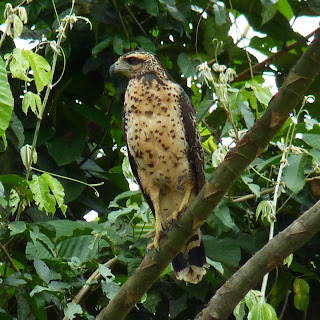
...and a totally badass Sunbittern!

...not a great photo unfortunately.
Another nice vantage point was a gazebo by the dock overlooking the river. A nearby fruiting tree was a popular spot for Dacnis, such as:
 ...this Yellow-bellied
...this Yellow-bellied
 ...and this Black-faced
...and this Black-faced
Combining our lists for the 6 days we had a little over 170 bird species (we each individually had around 165) and also saw 8 types of monkeys. Bird highlights were many, but to name a few: the macaws, the Salvin's Curassows (we saw 7 individuals in one day), the Bartlett´s Tinamou, Gray-winged Trumpeter, Black-faced Hawk, and of course the Hoatzins: There were loads clambering clumsily among the trees by La Laguna.
There were loads clambering clumsily among the trees by La Laguna.

He was off with his species guess of Cinereous...this was actually a Bartlett's (correct me if I'm wrong!)
Now before I dive headfirst into the Amazon I should mention that I will be paraphrasing myself from my other blog's post from back in April: Elementary my dear Hoatzin. If this current post leaves you wanting more (like pictures of monkeys), then follow that link.
Alright let's give this place some context:
View Larger Map
Yeah, this place is a bit out of the way. Travel from the nearest airport (Coca) takes 6 hours and 3 legs via boat, truck and motorized canoe. So you'll have to budget a day of travel each way.
They neither solicit nor discourage "tourists" or birders from visiting; the station is primarily for researchers: tropical ecologists, primatologists, ornithologists, etc. to conduct field work. So it has a much different (and refreshing) vibe to it, than the standard Amazonian ecotourism lodge. They do have fantastic and knowledgable resident guides who know all of the place's 550+ species and ours, Jose, showed spent a couple days enthusiastically leading us around a few of the trails.
I ended up at Tiputini because I had the serendipity to meet one of the station's directors, Prof. Kelly Swing, while he was visiting La Hesperia with a group of students.
I managed to convince my buddy, Peter Capobianco, to fly down from the states to get in on the trip as well.
Anyway, on to the birds:
What stood out most about the bird life at Tiputini, aside from the staggering total species diversity, is that so many of the birds encountered were considered either "rare, scarce or local" according to the field guide (Ridgley and Greenfield). Most birds were encountered only a single time. For a serious birdwatcher this does demand constant vigilance as a once-in-a-lifetime type species could show itself at any moment and then disappear just as quickly. For us this happened when were were with Jose when he spotted an (to us anyway) invisible Rufous-vented Ground Cuckoo. He said it was the second one he had seen at Tiputini in four years. Don't worry I made up for it later at Jatun Sacha Bilsa (account coming soon to a blog near you!).

Not a mega-bird, but one example of something "rare" that cooperated for a photo was this Black-bellied Cuckoo that joined us in the 35-meter canopy tower. We must have spent 40 hours in that tower over the course of our six full days at the station. It was an awesome spot to see passing groups of macaws (we saw lots of Scarlet as well as Blue-and-Yellow and Chestnut-fronted), canopy flocks (loaded with Paradise, Opal-rumped and Opal-crowned Tanagers) and various toucans including:
Many-banded Aracari.

And here a Common Piping-Guan:

...and a Double-toothed Kite:

...also joined us in the canopy tower.
Along the river we found a foolishly tame juvenile Great Black-Hawk:

...and a totally badass Sunbittern!

...not a great photo unfortunately.
Another nice vantage point was a gazebo by the dock overlooking the river. A nearby fruiting tree was a popular spot for Dacnis, such as:
 ...this Yellow-bellied
...this Yellow-bellied ...and this Black-faced
...and this Black-facedCombining our lists for the 6 days we had a little over 170 bird species (we each individually had around 165) and also saw 8 types of monkeys. Bird highlights were many, but to name a few: the macaws, the Salvin's Curassows (we saw 7 individuals in one day), the Bartlett´s Tinamou, Gray-winged Trumpeter, Black-faced Hawk, and of course the Hoatzins:
 There were loads clambering clumsily among the trees by La Laguna.
There were loads clambering clumsily among the trees by La Laguna.We were a bit unfortunate in our timing in that we missed the ornithologist who was mist netting understory species. It would have been nice to see some of these birds up close as finding them in the field we both decided was some of the most difficult bird-watching either of us had ever experienced, because of the poor light under three or four layers of canopy, the density of the habitat, and the diversity of similarly plumaged species (i.e. dusky-throated antshrike vs cinereous antshrike).
Another bit of bad timing was that the mannikins happened to be molting rather then displaying and every individual we did happen to see was immature/female and essentially unidentifiable. Otherwise we probably would have added 6 or so charismatic species to our lists.
I was really hoping for a Harpy Eagle, which are erratic, but regular at the station. It's hard to really complain though:
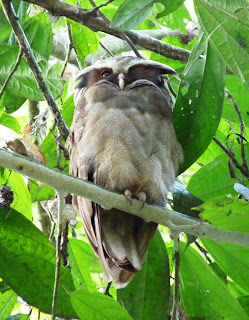
This Crested Owl was one of many "consolation prizes." A big thanks Jose for this stakeout; it was my first owl sighting in Ecuador!
I hope the mediocre photos managed to pull you through all the text. For wayyy better shots check out Pete's work here. Pages 1 through 10 have Tiputini pictures. My personal favorite.
More information about Tiputini can be found here.
I would end on video, but don't have anything from Tiputini worth showing. Sooooo instead let's have another nest quiz!
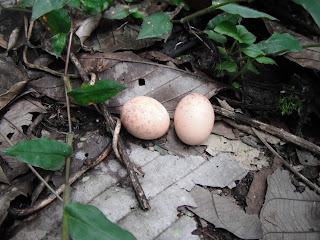
Hint: this one was found at approximately 1500 meters elevation on a trail at La Hesperia (about 2 hours west of Quito).
Good luck!
Another bit of bad timing was that the mannikins happened to be molting rather then displaying and every individual we did happen to see was immature/female and essentially unidentifiable. Otherwise we probably would have added 6 or so charismatic species to our lists.
I was really hoping for a Harpy Eagle, which are erratic, but regular at the station. It's hard to really complain though:

This Crested Owl was one of many "consolation prizes." A big thanks Jose for this stakeout; it was my first owl sighting in Ecuador!
I hope the mediocre photos managed to pull you through all the text. For wayyy better shots check out Pete's work here. Pages 1 through 10 have Tiputini pictures. My personal favorite.
More information about Tiputini can be found here.
I would end on video, but don't have anything from Tiputini worth showing. Sooooo instead let's have another nest quiz!
Hint: this one was found at approximately 1500 meters elevation on a trail at La Hesperia (about 2 hours west of Quito).
Good luck!




